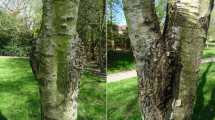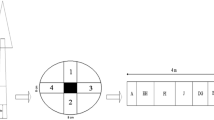Abstract
Living tree branches are almost impossible to snap. Some show “greenstick fracture”, breaking halfway across before splitting along their length, while others simply buckle. In this study we investigated the bending failure of coppice branches of three temperate angiosperm trees: ash, Fraxinus excelsior; hazel, Corylus avellana; and white willow, Salix alba. We carried out bending tests, and made a series of observations on the structure, density and tensile and compressive strength of their wood to understand the pattern of failure. The three species showed contrasting behaviour; willow buckled whereas ash showed clean greenstick fracture and hazel a more diffuse greenstick fracture. These differences could be related to their wood properties. Willow buckled because its light wood had very low transverse compressive strength, particularly tangentially and was crushed by transverse stresses. Though the other species yielded in longitudinal compression on the concave side, they ultimately failed in tension on the convex side when bent because their higher density wood resisted transverse compression better. However, the crack was diverted down the midline because of the low tangential tensile strength of their wood. Differences in fracture between ash and hazel are related to fine-scale differences in their wood anatomy and mechanics.










Similar content being viewed by others
References
Beismann H, Wilhelmi H, Bailleres H, Spatz H-C, Bogenrieder A, Speck T (2000) Brittleness of twig bases in the genus Salix: fracture mechanics and ecological relevance. J Exp Bot 51:617–633
Bowyer JL, Shmulsky R, Haygreen JG (2003) Forest products and wood science: an introduction. Iowa State Press, Iowa
Carlquist S (1988) Comparative wood anatomy. Springer-Verlag, Berlin
Clarke SH (1933) On estimating the mechanical strength of the wood of ash (Fraxinus excelsior L.). For 7:26–31
Dresch HE, Dinwoodie JM (1996) Timber; structure, properties, conversion and use. Macmillan Press, London
Ennos AR (1991) The mechanics of anchorage in wheat Triticum aestivum L.: II. Anchorage of mature wheat against lodging. J Exp Bot 2:1607–1613
Ennos AR (2001) Trees. The Natural History Museum, London
Ennos AR, van Casteren A (2010) Transverse stresses and modes of failure in tree branches and other beams. Proc Roy Soc Lond B 277:1253–1258
Hacke UG, Sperry JS, Pittermann J (2000) Drought experience and cavitation resistance in six shrubs from the Great Basin, Utah. Basic Appl Ecol 1:31–41
Huang CL, Lindström H, Nakada R, Ralston J (2003) Cell wall structure and wood properties determined by acoustics—a selective review. Holz als Roh- und Werkstoff 61:321–335
James KR, Haritos N, Ades PK (2006) Mechanical stability of trees under dynamic loads. Am J Bot 93:1522–1530
Mattheck C, Kubler H (1995) Wood: the internal optimization of trees. Springer, Berlin
Metcalfe CR, Chalk L (1983) Anatomy of the Dicotyledons, 2nd edn. Claredon Press, Oxford
Reiterer A, Burgert I, Sinn G, Tschegg S (2002) The radial reinforcement of the wood structure and its implication on mechanical and fracture mechanical properties—a comparison between two tree species. J Mater Sci 37:935–940
Richter HG, Dallwitz MJ (2000) Commercial timbers: descriptions, illustrations, identification, and information retrieval. In English, French, German, and Spanish, vol. 2009 http://www.biologie.uni-hamburg.de/b-online/wood/english/index.htm
Saranpaa P (2003) Wood density and growth. In: Jeronimidis G, Barnett JR (eds) Wood quality and its biological basis. Blackwell Publishing, Oxford
Tsoumis G (1991) Science and technology of wood. van Nostrand Reinhold, New York
Vincent JFV (1992) Biomechanics materials a practical approach. Oxford University Press, Oxford
Zink-Sharp A (2003) The mechanical properties of wood. In: Jeronimidis G, Barnett JR (eds) Wood quality and its biological basis. Blackwell Publishing, Oxford
Acknowledgments
This study was supported by the NERC grant NE/F003730/1. We would like to thank Dr Richard Cutting and Dr John Waters of the School of Earth, Atmospheric and Environmental Sciences University of Manchester for use and assistance of the scanning electron microscopes.
Author information
Authors and Affiliations
Corresponding author
Additional information
Communicated by R. Matyssek.
Rights and permissions
About this article
Cite this article
van Casteren, A., Sellers, W.I., Thorpe, S.K.S. et al. Why don’t branches snap? The mechanics of bending failure in three temperate angiosperm trees. Trees 26, 789–797 (2012). https://doi.org/10.1007/s00468-011-0650-y
Received:
Revised:
Accepted:
Published:
Issue Date:
DOI: https://doi.org/10.1007/s00468-011-0650-y




